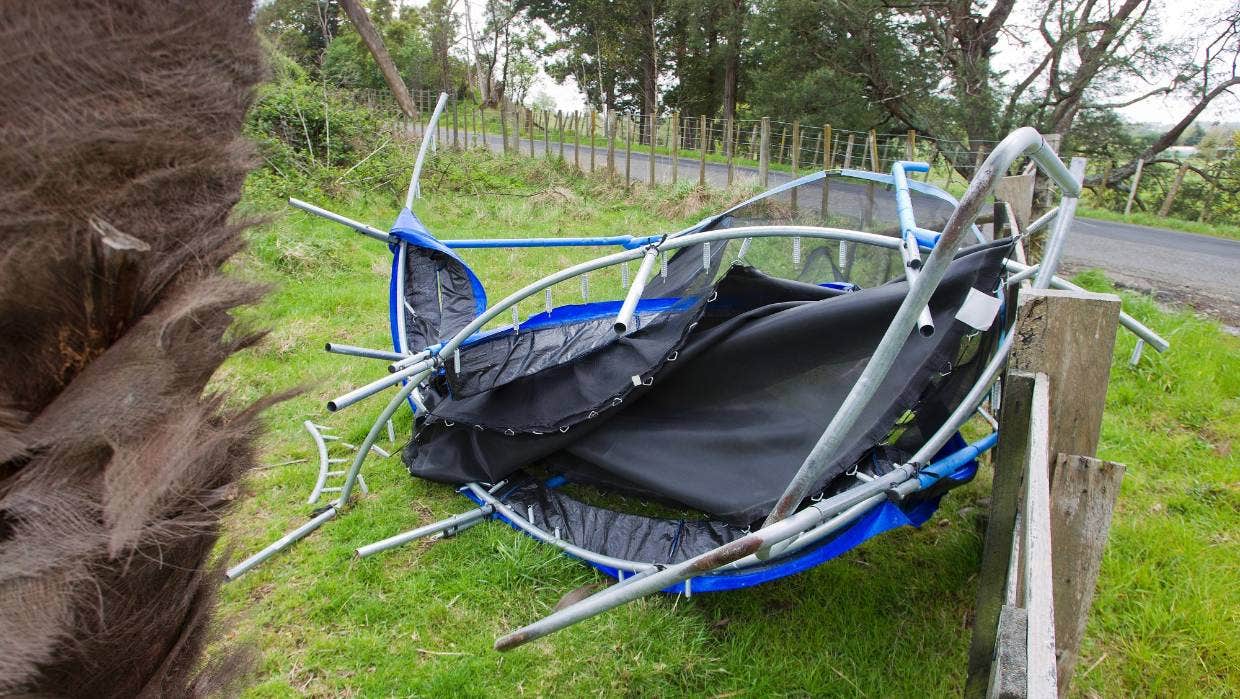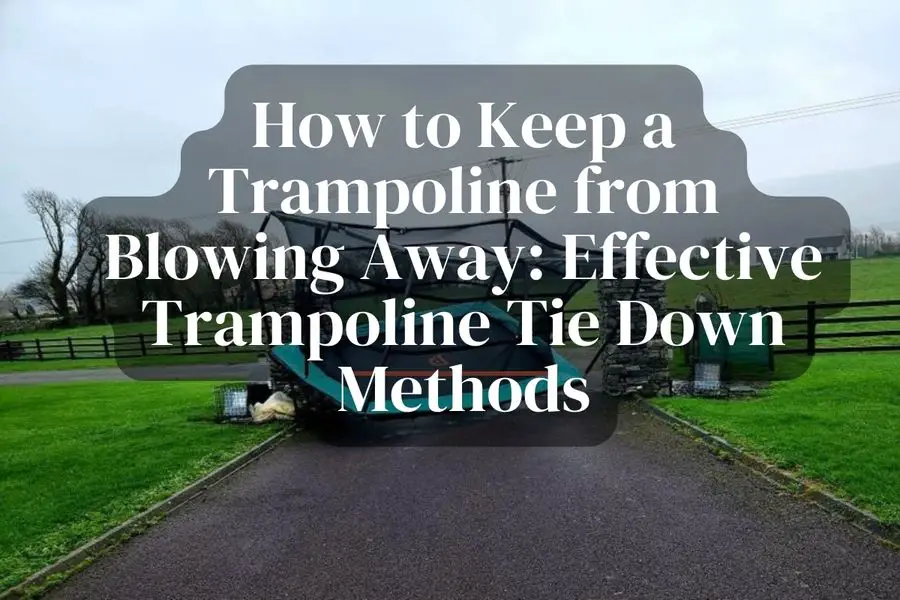If you own a big yard, the idea of having a trampoline must have crossed your mind. But the next minute, you refrain from the thought because your trampoline can get blown away due to wind or extreme weather. So, how to keep a trampoline from blowing away, then?
Well, no matter how strong the winds, storms, or cyclones strike, there’s a magic bullet for these problems. Securing the trampoline by anchoring and weighing down the trampoline are the two most effective methods that you can apply.
This blog has everything explained and covered for you. So, without further ado, let’s binge on!

How To Keep A Trampoline From Blowing Away?
Trampolines are a popular outdoor activity for families, but they can be dangerous if they are not properly secured. One of the biggest concerns is keeping a trampoline from blowing away during high winds. Fortunately, there are several steps you can take to ensure that your trampoline stays in place.
The first step in preventing a trampoline from blowing away is to make sure it is properly assembled. The legs should be securely attached to the frame and the frame should be securely attached to the jumping mat. If any part of the trampoline is loose, it will be more likely to move during strong winds.
Next, anchor the trampoline with stakes or sandbags. Stakes should be inserted through the frame and into the ground at each leg. Sandbags can be placed on the base of the trampoline, or tied to the frame with ropes. Both options will help to provide extra stability to the trampoline, preventing it from tipping over during high winds.
It’s also important to check the weather forecast and take precautions when high winds are predicted. If strong winds are expected, consider disassembling the trampoline and storing it indoors until the weather improves.
Regular maintenance can help to keep a trampoline in good condition and less likely to be affected by high winds. Check for any damage or wear and tear, and replace any broken parts as needed.
How to anchor down a trampoline?
Anchoring down a trampoline is a crucial step to ensure its safety and stability. Without proper anchoring, the trampoline can tip over or move during windy weather, causing potential damage or injury. Here are some steps you can take to anchor down your trampoline:
Choose the Right Anchors
Before anchoring your trampoline, make sure you choose the right type of anchors. There are various options, such as stakes, augers, and concrete anchors. Consider factors such as the size and weight of your trampoline, the type of soil in your yard, and the local weather conditions.
Position the Trampoline
Once you have your anchors, position the trampoline in the desired location. Make sure the legs are even and level, and that there is enough clearance around the trampoline to prevent any potential hazards.
Insert the Anchors
Next, insert the anchors into the ground. For stakes or augers, use a mallet to hammer them into the ground as far as possible. For concrete anchors, follow the manufacturer’s instructions for mixing and pouring the concrete.
Attach the Straps
After inserting the anchors, attach the straps to the hooks on the legs of the trampoline. Make sure the straps are tight and secure, with no slack. The straps will help to keep the trampoline in place during windy weather.
Let’s check the best way of anchoring a trampoline:
Tips & Tricks for Tying Down a Trampoline
Above all, if you get signs of a hurricane or cyclone, you should move the trampoline inside your house. Sometimes no matter how secured your trampoline is, heavy storms would manage to blow it away.
If we talk about the usual weather situations like heavy winds, there would be two options open for you besides moving it indoors:
- Securing the trampoline by anchoring
- Weighing down the trampoline
Method-1: Securing the Trampoline by Anchoring
An anchor is a practical yet effortless way to freeze your trampoline during heavy winds. You’ll be using the anchor to secure it in the ground firmly. The anchor type will depend on the trampoline model, the location, and, of course, your own preferences.
The two ways of anchoring a trampoline would include:
- Anchor tools, including straps
- Wind stakes
Let’s review the quick methods and see if they fit your preferences.
- Way-1: Anchor Tools, Including Straps
You should get anchor kits with straps and corkscrew-like stakes. With these, your trampoline will get a secure fit. Since anchors are made with high-quality galvanized steel material, there’s no way they can get rusty or corroded.
Thus, they’ll be able to hold a giant trampoline during the harsh air hours. Moreover, anchors stay strong for many years. Below are some of the anchor tool types.
- U-Shaped Anchors
U-shaped anchors are the basic, traditional, and cheapest way of anchoring. You can easily install them using a hammer. They can be fitted directly around the trampoline’s basic poles. Unfortunately, they aren’t that reliable when it comes to holding the trampoline down.
So, it won’t be entirely wrong to state it as a “basic protection.”
- Augers
Corkscrew trampoline anchors are more reliable anchoring kits, which are known as Augers. Their shapes are considered the most convenient for trampoline anchoring. Plus, augers are more gardening friendly and effortless to set up than the U-shaped ones.
You have to twist them into the ground like a corkscrew and attach them to the top, where you find the straps. Its ground screws are also galvanized, so you get an extended lifespan.
Moreover, the kit comes with four rigid trampoline stakes and anchors. You’ll get metal buckles and firm nylon straps as well. The screws go deep enough to hold the trampoline even though it’s storming outside.
Ins and Outs of Anchor Tools
Undoubtedly, anchor tools are the most effective way to keep your trampoline stable. But they aren’t pocket friendly. Also, not everyone knows how to install them as it’s quite a hard nut to crack. But without question, if these get installed, then they are the greatest shelters!
- Way-2: Wind Stakes
Wind stakes aren’t as tricky as anchor tools to install. They come in ‘J’ and ‘U’ shapes. With these, you can stamp your trampoline into the ground through its legs.
Moreover, these wind stakes come in different lengths, from 10 to 14 inches. This length would be more than enough for holding your trampoline deep inside the ground.
Ins and Outs of Wind Stakes
Wind stakes are very easy to install. They are cheap yet the quickest and an effective solution. Thanks to their 2.5-inch trampoline tube leg diameter, they go with every trampoline model. Although the depth won’t be as rigid as anchoring or auger structure, it’ll be an affordable and reliable pick.
Method-2: Weighing Down the Trampoline
If you aren’t up for spending money on anchors or wind stakes, it still isn’t the end of all the trampolining sessions. Weighing down the trampoline to hold it down is still open for you.
- Sandbags
A very popular and basic way to weigh down your trampoline would be using sandbags. All you got to do is put them on the legs of the trampoline. This way, the sandbag will keep the trampoline from blowing away during storms.
While anchors and wind stakes are off-limits, you can hold trampolines on the concrete surface using sandbags.
Note: You can have as many sandbags as possible; the more, the better!
- Alternative
However, it’ll be too time-consuming to arrange sandbags sometimes. In this case, you can use any heavy stuff you want. Just make sure they will have a good grip on the trampoline.
For example, you can use old and heavy tires. Instead of throwing them the moment they get old, you can store them in the corner of the backyard. Then you can use them for your trampoline whenever you feel the urge.
How To Tie Down A Trampoline?
Tying down a trampoline is an important step to ensure the safety of its users and prevent damage to the equipment.
The first step is to assemble the trampoline properly, making sure all parts are securely fastened. Next, anchor the trampoline to the ground using tie-down straps or stakes. Stakes can be inserted through the frame and into the ground at each leg.
Tie-down straps can be wrapped around the frame and attached to a secure anchor point, such as a tree or fence post.
Regularly check the tie-downs to make sure they are still securely in place. Tying down a trampoline can prevent it from tipping over during high winds or excessive bouncing, keeping everyone safe while enjoying this popular outdoor activity.
How to secure a trampoline in high winds?
When high winds are in the forecast, it’s significant to properly secure your trampoline to prevent any potential damage or safety hazards.
The first step to securing a trampoline in high winds is to ensure that it is placed on level ground. This will prevent any wobbling or shifting that can occur during strong gusts of wind. It is also vital to clear the area around the trampoline of any debris or objects that can be blown into it.
One of the most effective ways to secure a trampoline in high winds is by using anchor kits. These kits include stakes that are driven into the ground and attached to the trampoline frame with straps. This creates a solid and stable base that can withstand strong winds.
Another option is to use sandbags or weights to weigh down the trampoline. This method is especially useful if the trampoline cannot be anchored into the ground due to concrete or other hard surfaces. Simply place sandbags or weights around the base of the trampoline to keep it from tipping over.
Keep note that, regularly inspect the trampoline for any signs of wear and tear. Replace any damaged parts or springs to ensure that it remains safe and secure during high winds.
By following these tips and using the right equipment, you can keep your trampoline safe and enjoyable for years to come.
Securing trampoline from blowing away
Bottom Line
So, we hope our suggestions on how to keep a trampoline from blowing away are comprehensive. And it’s not worth it to have a trampoline if you simply can’t protect it during rough climates. Therefore, do ensure that you follow the methods mentioned and keep your trampoline safe and sound in all ways possible!
Frequently Asked Questions
Is it okay to secure a trampoline with an anchoring kit?
Actually, it would be the best way to hold your trampoline down. They place the most robust contact between the ground and your trampoline’s legs. Although it’s a bit hard and expensive to install, once it’s done, your trampoline will be secured for the rest of its lifespan.
Is it mandatory to secure the trampoline?
It indeed is, unless you want your trampoline to fly away with heavy wind. We can trust the trampoline base for regular light winds. But storms and cyclones are too much to risk. Plus, it’s really difficult and annoying to get the whole trampoline inside every time we see some changes in the weather.
How can I secure a trampoline on a concrete surface?
By weighing the trampoline down. Anchors and augers can’t go deep inside the concrete surface. You can use either sandbags or old tires to do the job.
Last Updated on August 25, 2023

